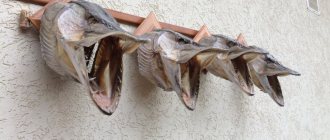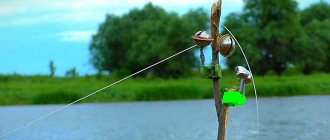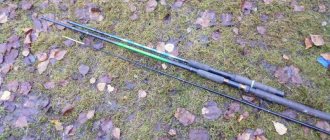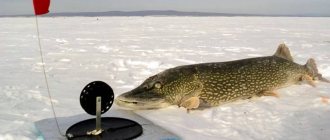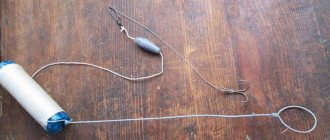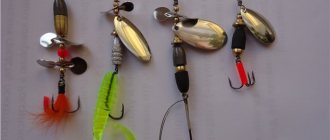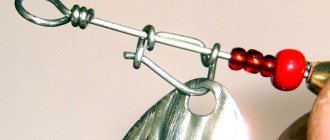Design and equipment of the girder
First, let's look at the principle of operation of the girder, learn how to properly rig it, and how to attach live bait.
Video: Fishing for pike with girders in winter, how to assemble a girder
Essential elements
The zherlitsa has many shapes and manufacturing options, whether purchased or homemade. However, the main elements (see photo) in it, as a rule, remain unchanged. This:
- base with flag;
- coil;
- fishing line;
- sinker;
- swivel;
- leash;
- hook.
Basic elements of the girder
Principle of operation
A special feature of the girder is its very simple operating principle. It works like this:
- The live bait falls into the hole.
- The fishing line of the required length is unwound.
- The spool with fishing line is fixed by bending the flag and resting on the spool of the reel.
- When the bite occurs, the pike will try to drag the bait away.
- The line will begin to unwind from the reel.
- The signaling part of the rod will be released and rise up, eventually starting to signal the angler about a bite.
By installing the girders at different depths (near the bottom, in mid-water, closer to the surface), you can significantly expand the search horizon for pike.
The main disadvantage of the hole is that the open hole can become covered with ice at any moment.
How to equip a winter rig for pike
Installation and equipment of a winter girder for pike occurs as follows:
- the required amount of fishing line is wound onto the reel;
- a sinker is attached (can be either fixed or sliding);
- A winding ring or a carabiner (swivel) is attached to attach the leash. Instead, you can simply tie an end loop. Some anglers prefer to attach the leader directly to the working line.
- a leash is mounted;
- hook(s) are attached.
Thus, there are practically no special difficulties in equipping a winter girder for pike. This work can be handled not only by a professional with significant experience, but also by a beginner who has decided to test his strength in this type of activity for the first time.
How to bait live bait
There are several options for how you can attach live bait to a girder, such as:
- For the nostrils . This method is considered one of the simplest. It involves hooking the two nostrils of a live bait fish with a single hook. In this case, you need to be as careful as possible. This is due to the possibility of damage to the nasal cavity of the fish. That is why, in order to avoid such a situation, you should choose those species that have a fairly strong head anatomy. It is best to place live bait on the girders through its nostrils if necessary, when fishing in reservoirs without a current.
- For the lips . This method is different in that it requires a certain amount of prudence. This is due to the fact that not every fish has strong lips. If the bait is large enough, over time it may break off on its own. To hook the fish by the lips, you must use only a single hook. It performs its functions better in this case. If there is no current, you can hook the bait only on the upper lip. In the opposite situation, it is recommended to thread the hook additionally through the nostril.
- For the gills . This method requires special caution from the fisherman. This is due to the fact that improper placement can cause the rapid death of the fish. If this happens, it will be impossible to interest the pike in it. In order for the process to go as correctly as possible, you need to unhook the leash or significantly loosen it. Otherwise, the live bait will be too constrained. This in turn can lead to the predator refusing to attack.
- Behind your back . This method is used by most fishermen. This is due to the fact that the fish in such a situation has the opportunity to carry out fairly natural movements. In order to ensure this, you must be extremely careful when planting. If this is not the case, the baitfish will lose the ability to move. The hook can be made behind the back either between the fin and the ridge, or directly in the area of the spine. The first method is safe for the fish, while the second is considered more reliable. Therefore, most fishermen give their preference to the second option. The hook is usually a tee.
About
Main components
The equipment of the winter vent includes:
- Main line
- Cargo
- Stopper
- Carbine
- Leash
- Hook
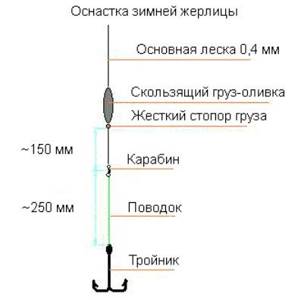
The correct choice of components allows you to successfully hook and avoid the fish falling off when retrieving. After all, you have to remove it from the hole directly by the fishing line, and not with the help of a landing net, as happens when fishing with a fishing rod. Therefore, we will consider in detail what characteristics the above listed components should have.
Working line
Among the main characteristics of the working line are:
- Thickness
- Length
- Node type
- Material
Thickness is determined by the experience of the angler and the expected size of the fish. In places with large concentrations of pike, for example, in the northern regions, this is 0.4-0.5 mm, in the middle zones - no more than 0.35 mm. In wild places, this subspecies of river fauna can even bite on thick fishing line, and in areas of constant contact with fishermen, it is unlikely to take bait with a thickness of more than 0.3 mm. If you need to catch trout, pike perch, rotan, perch, there is no need for a fishing line thicker than 0.25-0.35 mm. A thinner one will quickly tear, and a thicker one will get tangled.
When going for pike, you need to equip the fishing reel with about 15-30 meters of fishing line. This is explained primarily by the fact that such a predator is extremely careful, and while it swallows the fish to a level sufficient for hooking, it swims away 2-3 tens of meters. Moreover, according to the practice of experienced fishermen, she exhibits such habits even if the reservoir is only a meter deep.
The deeper the bottom, the more fishing line you will need. There is a simple calculation formula: line length = depth + 10 meters
. The exception is stumpy places (which will be discussed below). For small fish, the length of the line is significantly reduced. For example, for rotan 1-2 meters is enough.
The unwinding force of the coil is not always the same. Sometimes it can become so intense that the line simply falls off. Therefore, when winding after the first turn, the line should be secured using a standard self-tightening loop, or an arbor
(axial node).
See the picture below:
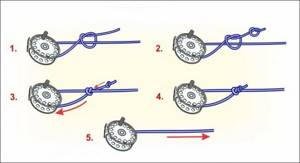
To equip a winter fishing line, the fishing line material must meet the following requirements:
- Low elongation
- Minimum memory
- Resistance to minor damage and cuts from the edge of the hole
- Saving properties
Special winter monofilament fishing lines made of nylon or their analogs made of fluorocarbon and fluorocarbon have parameters that are as close as possible to these standards.
Hi-tech Line Nylon Fluorescent Yellow 100 m Helios 145 for 1 pc. Hi-tech Line Nylon Transparent 100 m Helios 145 for 1 pc. Line Royal Carp 150 m brown Rubicon 120 for 1 pc. Line Extra Strong 150 m Rubicon 160 for 1 pc. Line Crystal 150 m light gray Rubicon 120 for 1 pc. Carbon Leader line 25 m, transparent Momoi 530 for 1 pc. Trolling Line 150 m transparent Momoi 299 for 1 pc. Line SPINNING SPECIALIST 135 m Kosadaka 149 for 1 piece. Line SKYLINE Fluorocarbon Composition Evo Tech PRO GhostInv 250 m Sprut 389 for 1 pc. Line FEEDER PRO SINKING 150 m Dark Green ALLVEGA 441 for 1 pc. Monofilament fishing line Gold Carp Battler 150 m brown, sinking ALLVEGA 475 for 1 pc. Spider Perch line 100 m 0.2 vacuum/pack gray SWD 122 for 1 pc.
Sinkers
For all types of girders, sinkers with a through hole are best suited. Such sliding elements allow the bait to be kept at a given depth, and the predator is not given the opportunity to immediately detect the trap and have time to swallow the bait. Loads of this type are carried out in the form:
- Sharika
- Cylinder
- Cone
- Olives
- Double cone
Its mass should restrain the baitfish from excessive movements, but not allow it to fall asleep. In shallow currents and when there is stagnation, it is optimal to take a weight equal to a tenth of the fish’s weight, and in fast waters – an eighth
. When the river flow is literally turbulent, it is permissible to throw the end weight to the bottom to hold the equipment at one point, and make a diverting leash for the bait.
When equipping it, it is important to take into account the resistance created by the load in the water at the moment of biting - when the predator begins to pull. Therefore, it must be placed with the narrow or streamlined end towards the hook. This rule is especially relevant when catching cautious inhabitants of reservoirs.
Installing a rubber stopper bead on the main line allows you to increase the height of the weight relative to the live bait, and gives the latter more freedom. This need often arises when changing different fishing spots with different bottom topography.
Olive sliding weight 10 g Tonar 8 for 1 pc. Weight Cylinder with swivel 10.5 g (Drop Shot) Tonar 11 for 1 pc. Weight Cylinder with swivel 18 g (Drop Shot) Tonar 14 for 1 pc. Load Drop with eye 10 g Tonar 11 for 1 pc. Load Drop with eye 18 g Tonar 15 for 1 piece. Weight Cylinder with swivel 7 g (Drop Shot) Tonar 10 for 1 pc. Weight bullet cone sliding 10 (10.5) g Tonar 8 for 1 pc. Weight Cylinder with swivel 14 g (Drop Shot) Tonar 12 for 1 pc. Weight bullet cone sliding 9 g Tonar 8 for 1 pc. Olive sliding weight 21 g Tonar 12 for 1 piece. Olive sliding weight 14 g Tonar 9 for 1 piece. Weight bullet cone sliding 7 g Tonar 7 for 1 pc. Weight bullet cone sliding 14 g Tonar 9 for 1 pc. Weight Bullet for Carolina equipment 18 g Tonar 15 for 1 pc. Olive sliding weight 85 g Tonar 40 per 1 piece. Load Drop with eye 14 g Tonar 12 for 1 pc. Weight bullet cone sliding 18 g Tonar 11 for 1 pc. Bottom skittle weight 14 g Tonar 9 for 1 pc. Weight bullet cone sliding 12 (12.5) g Tonar 9 for 1 pc. Load Elongated drop 14 g Tonar 15 per 1 piece. Weight Cylinder with swivel 16 g (Drop Shot) Tonar 13 for 1 pc.
Leashes
It is necessary to equip the girder with a leash if you are going to catch pike. Since it easily cuts through regular monofilament thread. As for the choice of materials, the best options are:
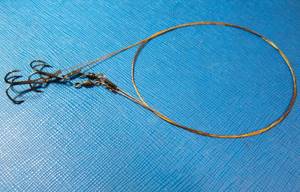
- Metal wire
. Made from thick guitar strings or cable conductors. Features maximum strength. However, it significantly limits live bait. Therefore, it is recommended to use for very active pike during the period of young ice. - Twisted nichrome
. It is characterized by better softness and mobility than the option described above, but is still very noticeable under water. - Lead base
. This is a special material based on several steel rods twisted into one strand. Its advantages are minimal thickness, softness and the ability to make loops yourself. - Kevlar
. Technological, lightweight, durable and soft structure. - Fluorocarbon
. It is characterized as the most invisible in the water. Therefore, it is recommended for equipment in the wilderness with minimal predator activity. - Pigtail based on monofilament threads
. It consists of two or three braided fishing lines, separately connected to a hook. When snacking, even if one of them remains, the catch is guaranteed.
The general rule for choosing a material is this: while the pike is active, preference should be given to strength, and during the period of passive behavior, preference should be given to invisibility. When winter fishing for less toothy representatives of river fauna (pike perch, trout, perch), you can do without a leash and tie the hook directly to the main fishing line.
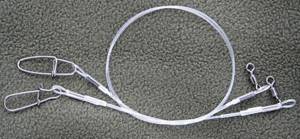
It is better to make the leash within a quarter of a meter in length. A longer version will be easily noticeable, while a shorter one will jeopardize the working line.
Leash equipped dl. 25cm. test 15kg. PIERCE 30 for 1 piece. Leash equipped dl. 25cm. test 9kg. PIERCE 20 for 1 piece. Set of leashes 7*7 (green 9kg L-15,20,25cm) “East Coast” No. 4 (36pcs) 708 for 1 pack.
Hooks
If the size of the hook is determined by the dimensions of the predator itself (for example, for pike it is 10-12), then its type is determined solely by the type of baitfish and the method of installation:
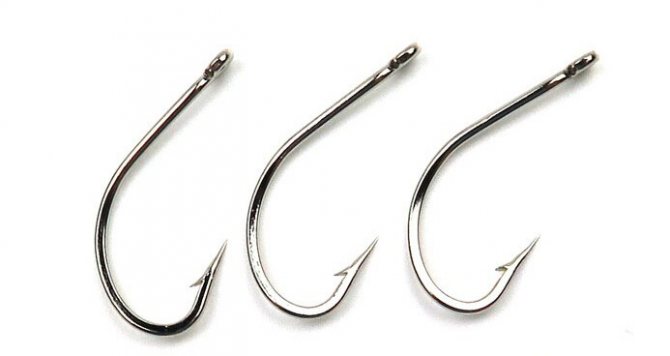
- Single
- for fry, sprat, baited through the mouth. - Double
- on the roach under the gills. - Tee
- for roach, crucian carp or perch behind the back.
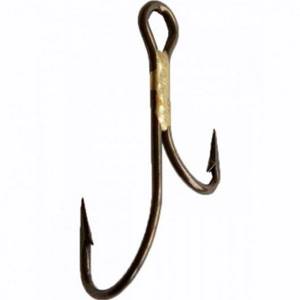
The triple hook is more effective, but also less secretive. Sometimes the predator does not swallow the fish whole, but fiddles with it for a while. This increases the likelihood that he will stumble upon the sting of the tee. The double eliminates this drawback; moreover, it is more convenient for hooking on the gills.
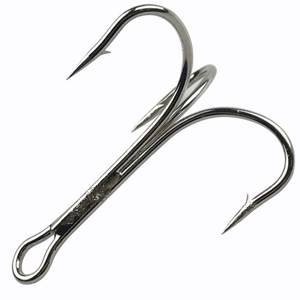
Whatever the design or size of the girder hook, first of all it must be strong and sharp. Its surface must be free from foreign matter or rust. The slightest odors caught in the water will scare away the predator.
Double hooks Double Hook art. KH11040-3/0/1 Rubicon 605 for 1 pack. Double bait hook, multi-level, solderless No. 1/0, BN coating (8 pcs) FISH SEASONS 110 for 1 pack. Triple hook (HS-ST-36-20) Helios 46 for 1 pc. Double bait hook, multi-level, solderless No. 3/0, BN coating (6 pcs) FISH SEASONS 100 for 1 pack. Double hook TW-01BC-02 OWNER 375 for 1 pack. Triple hook (HS-ST-36-1) Helios 24 for 1 pc. Double bait hook, multi-level, solderless No. 2/0, BN coating (7 pcs) FISH SEASONS 102 for 1 pack. Triple hook (HS-ST-36-2) Helios 23 for 1 pc. Double hook (HS-SD-36-2) Helios 33 for 1 pc. Hook Sting Double SSD1200 No. 1/0 Nautilus 20 for 1 pc. Triple hook ROUND (3R-BLN-01) METSUI 975 for 1 pack.
Accessories
When equipping the vent yourself, you will need the following fittings:
- Swivel
- Carbines
- Winding rings
- Stoppers
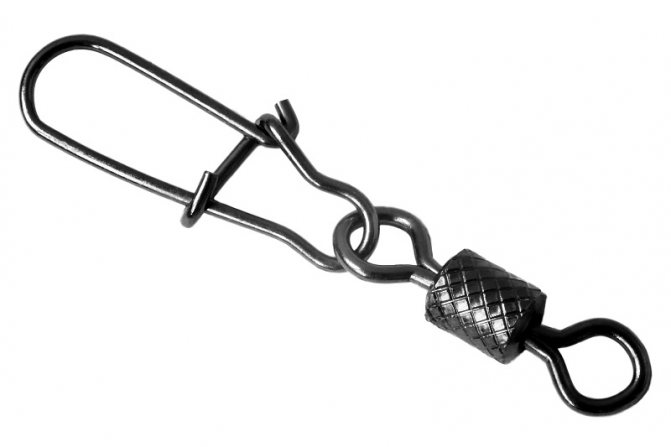
It’s good when the swivel and carabiner come in one design - two in one. On the one hand, it prevents the line from twisting, on the other hand, it allows you to quickly change the leash.
How to catch pike in winter using girders
Catching pike with girders in winter, with girders placed on the pond
In order to ensure a good catch, you first need to choose the right place for fishing. Ideally, it would be to discover the habitat of the pike. Having found a fish outlet, in one day you can catch up to 5-7 individuals of these predators and, perhaps, a large pike will be among them. This is normal for a nerd. If desired, you can also fish at night.
Where to place the girders?
In winter, pike are mainly found in the pond in ambush. From the same place she constantly watches the fish swimming nearby. As soon as the prey approaches the required distance, the predator suddenly attacks it.
It is necessary to make winter supplies and install girders in certain places depending on the type of reservoir:
- On the rivers . In this case, it is better to choose deep bays, holes under rifts, small pools, or plants above capes.
- On ponds and lakes . In such a situation, you need to navigate along the boundaries of vegetation. You can also choose places in the channels between the island and the shore. You need to pay attention to snags, cliffs and bushes.
To examine the bottom of a reservoir, it is best to use an echo sounder. If the reservoir will be visited for fishing in the future, you can use a jig or a spinner instead. In the process of examining the bottom, it is important to note for yourself various changes in depth or the presence of any obstacles. It would not be superfluous to analyze the behavior of local fishermen, since they must know exactly all the features of a particular reservoir.
How to properly place girders on pike in winter?
Good, interesting and effective fishing can be ensured by correctly stopping the girder. To do this, you need to adhere to the following tips:
- it is worth choosing steep banks;
- the current at the site where the hole is created should be slow and calm;
- the distance to the shore should not exceed 20 meters.
About
The process of making a winter vent with your own hands
winter zherlitsa. DIY girders Ice Fishing
Girdles made of galvanized and stainless wire
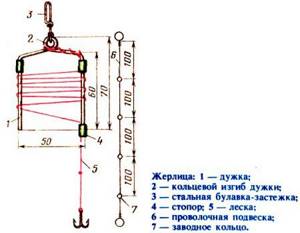
To bend a reliable frame for the girder, you need to take a wire with a diameter of at least 3 mm and a length of 550 to 700 mm. The wire is bent to create a short and a long end. The short end does not reach the long end by approximately 100 mm. After this, the long end is bent so that it forms a spool holder.
A bite alarm made of flexible steel wire is attached to the short end. A bright flag is attached to the end of the alarm.
From a plastic tube

To do this, you need to take a plastic tube and cut off a part of the tube from it, from 10 to 16 cm long, depending on the fishing conditions. The thickness of the tube does not play a special role. For fishing from the shore, this can be a piece of tube from 13 to 16 cm long, and for fishing from ice, its length can be no more than 10 cm.
To begin with, a through hole with a diameter of about 6 mm is drilled at one end of the tube, and a hole with a diameter of 8-10 mm is drilled at the other end. A thin but strong rope with loops will pass through these 2 holes. A fishing line with a hook should be attached to one loop using a latch.
To keep the live bait in the water column (fishing from the shore), a piece of foam should be attached to the fishing line.
Wood frame construction

As a rule, pine or aspen are used, which are more resistant to moisture.
- A reel is formed for the base of the structure. To do this, recesses are made on the end sides. To ensure that the line is pressed against the body of the reel, a wire retainer is screwed to it.
- On the front side there are 2 wire clips with bent ends.
- The thickness of the springs can be about 5 mm. One end of the spring is straightened by 9-10 cm.
- The spring is attached to a wooden base. One end must be securely fixed.
- A bright flag is attached to the straightened end. All that remains is to secure the fishing line with the hook and sinker, as well as bend the spring and secure it between the fixing parts. The zherlitsa is ready for use.
Subglacial vents
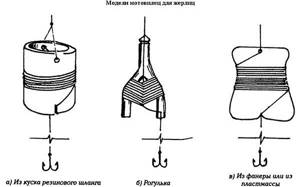
Such holes are easy to manufacture, since any unnecessary object that is longer than the diameter of the hole is suitable for this purpose. A plastic tube about 50 cm long should be attached to this object. A cut is made at the end of the tube so that the fishing line cannot fly off before the bite occurs. In case of a bite, the line jumps out of the cut, which allows the rest of the line to unwind freely from the tube. Since the tube is always in the water, such girders, left, for example, overnight, freeze by morning. To check it, you have to punch a hole nearby. Usually, with this method of fishing, the hole is covered at night, if, of course, there is something.
Made from duralumin strip and steel wire
The base of such gear is a duralumin strip (1x60x300 mm) with ends bent to one side. This will make it easier to install it on the ice. A hole is drilled in the center of the plate for attaching the coil, like an “ice block” or “hole”. A hole is drilled next to the reel for a fishing line with a hook.
The spring plays the role of a bite alarm, and an alarm made of bright material is attached to its end. The spring is attached to the end of the base and secured with a regular pin.
In working condition, the spring is pressed with a pin to the base. If there is a bite, the spring is released from the pin and ends up in a vertical position.
Two types from a rubber hose and using a spring from an alarm clock
- To do this, you need 2 pieces of rubber hose, with a diameter of 1.5-2.0 cm and a length of 10 cm. A hole is made at one end of the rubber hose for attaching a loop, up to 30 cm in size. On the other side of the piece, a cut is made, intended for rope fastenings.
The same tube is used as a reel, onto which 10 meters of cord is wound. One end of it is attached to the holes using a loop, and the other end of the rope is inserted into the slot at the other end of the hose. A weight and a leash made of fishing line up to 0.5 meters long should be tied to the free end of the rope, fixed in the slot. A leash made of monofilament is connected to a leash made of metal, to which a hook is attached. For ease of use, a reliable stick is inserted from the side of the loop, the length of which is greater than the size of the hole.
A bent piece made from a piece of steel wire to which a spring is attached serves as a bite alarm. The same part serves as a stopper.
- The stand is made of wood. A hole with a diameter of about 3 mm is drilled in it. Using a nylon cord, a steel section is attached to the stand, as well as a curved piece to which a spring with a signal element is fixed.
Usually, the structure is frozen into ice and all that remains is to install it in its working position by bending the spring and securing it with a stopper. In case of a bite, the stopper is released and the spring unbends, signaling a bite.
Features of fishing with girders
Winter fishing can be quite varied. It differs primarily in the climatic conditions of the period when the fisherman decided to go out to the reservoir. That is why it is extremely important for both beginners and professionals to understand what the main nuances of pike fishing are in early December, January, February or early March.
On the first ice
After the icing of the reservoir appears for about two weeks, the pike does not change its lifestyle. She does not swim away from her typical habitat, continuing to hunt in them for a certain time. This is due to the presence of a relatively significant number of fry in this area. Most often this concerns edges - places where there are significant differences in depth.
Catching pike on ice rigs on the first ice can be quite effective, but being on a body of water requires extreme caution.
In the wilderness
In the dead of winter, the danger of falling through the ice is usually minimal. That is why the precautionary rules during this period of time are less strict than when the first ice appears.
The main feature of pike fishing in the dead of winter is that the predatory fish at this time goes hunting for only 20 or 30 minutes. If you miss this period, the catch may be minimal. Often after fishing you can return home with nothing.
In order to catch a pike in winter in severe frost, you need to try hard. At the same time, you should have self-control, correctly following all the rules regarding such fishing.
About
Secrets of catching pike on girders
To obtain a catch, it is extremely important to focus not only on the existing rules, but also on certain secrets that experienced fishermen possess. They are as follows:
- If the atmospheric pressure changes greatly during the day, it is best not to go out to the pond.
- The length of the fishing line must be at least 30 meters, and its thickness must be from 0.3 to 0.4 millimeters.
- Every 15 minutes you should check the girder to a height of about 40-50 centimeters, as this can help attract the attention of the fish.
- Before you start fishing, you need to check the reservoir first. You need to start with reeds or other thickets. At the same time, you need to ensure that gear does not get tangled in reeds and other vegetation.
Types of girders for summer fishing
As can be seen in the photo of summer vents, according to their design features they are divided into:
- Postavushi.
- Hanging.
- Moored.
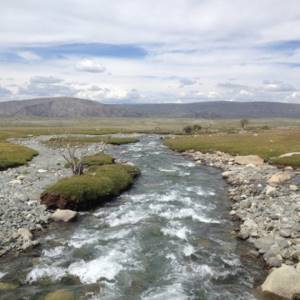
Each type differs not only in equipment, but also in the installation method.
«>
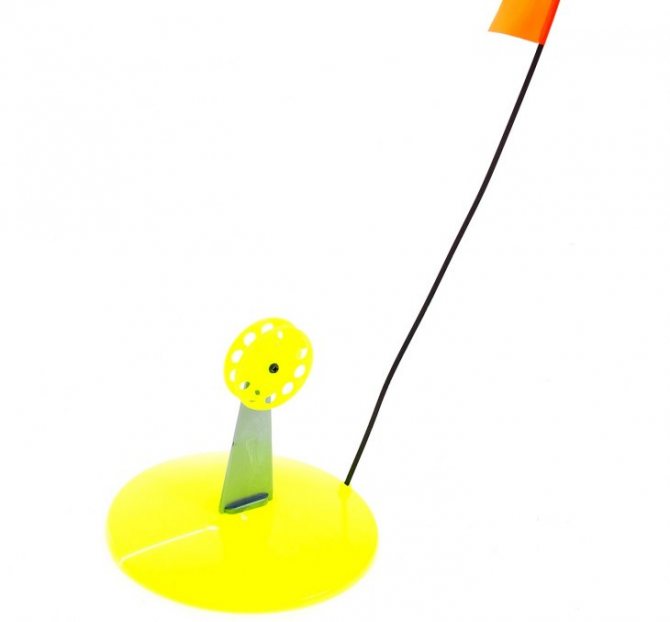
Zherlitsy from Aliexpress
Many fishermen are interested in how to order fishing rods from Aliexpress and save a little on their budget. However, this is not possible, since they are not presented in the online store. Yes, unfortunately, you cannot buy them on Aliexpress. There are two options left: buy girders in a domestic fishing store, or make them yourself.
Almost everyone can cope with winter pike fishing using girders. In this case, you need to be guided by the advice and recommendations given by experienced fishermen who spend a long time on reservoirs in order to obtain a significant catch. By adding to this your own practical experience and a little theory, you can achieve very significant results.
Views: 2,044
Similar articles:
- Catching pike with girders in the summer Today, fishing from a way of obtaining food has turned into entertainment, so...
- Fishing for pike with live bait in winter: which is better? Pike is a dangerous underwater predator that can destroy...
- How to put live bait on a pike hook Fishing with live bait most often makes it possible to catch really large...
- Pike fishing in winter Pike fishing in winter is especially interesting. This fish grabs so hard...
